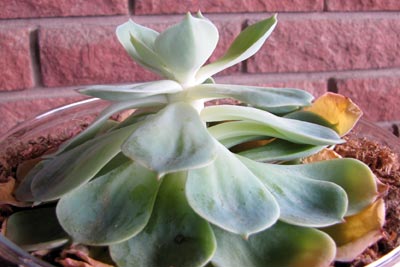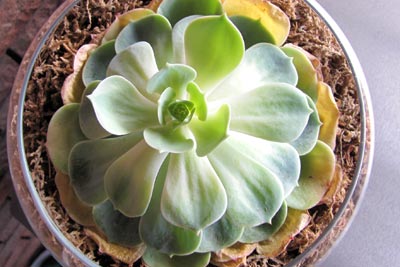Giant Succulent Echeveria Plants
Feb 12th 2012
Echeveria plants are a very large type of succulent. They look similar to sempervivums and both are often simply called Hens and Chicks. Both plants are drought resistant and can be propagated from offsets. However, here are a couple differences that are very useful to know when growing echeveria.
Echeveria do not die after flowering like sempervivums. They are polycarpic. In other words, they can flower several times during their lives. So, if you are growing both semps and echeveria together, be sure that you don't accidentally pull out the echeveria when a flower stalk appears.
Another big difference between echeveria and sempervivum is cold hardiness. Echeveria are native to Mexico and Central America and do not like to get very cold. Even here in the temperate climate of southern Oregon there are some years where echeveria survive unprotected and some that they don't. Well, that shouldn't be a deterrent to enjoying these great plants.
If you live in a cooler climate, you can move your echeveria into a greenhouse or build a shelter around them for the winter, but that just means you won't be able to enjoy these great plants as long as you should. The best way to overwinter some of the more tender succulents like echeveria is to brighten your house with them for the winter.
If you live in an area with months of freezing temperatures, plant your tender succulents in containers outside for the spring, summer, and fall. Then bring them inside when the temperatures start to drop. Echeveria work well as houseplants, but they need lots of sunlight. Put them wherever you want in your house and you'll quickly be able to see if they have enough light.
When it started getting cold outside at night, I brought an Echeveria inside to see how it would do with warmth, but low light.


After a few weeks on a wall without much light getting to it, predictably the plant began to stretch and turned a pale yellow-green color. The leaves began to die at an alarming rate and I thought it might be the end for the little guy.

I then moved it next to a window and a couple weeks later it had bounced right back to the proper rich green color and once again grew in a tight rosette instead of the elongated monstrosity.
Even if you live in a colder climate, you can enjoy echeveria plants all year long. Just watch your plants as they grow and they will tell you what they need.

